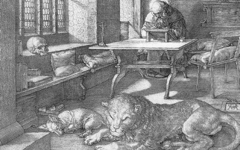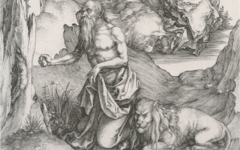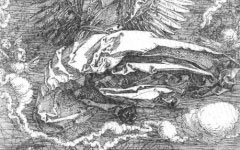Dürer’s Rape of Europa and Other Studies (1494-5)

Dürer, Rape of Europa and Other Studies (1494-5) Pen and brown ink. Albertina, Vienna.
Click image to enlarge.
These seemingly unconnected drawings by Dürer demonstrate how a great artist even when sketching thinks on another level. The left half of the page is a finished sketch for a Rape of Europa while in the upper section on the right are three lion heads. Beneath them are two figures who may or may not be linked: Apollo with his bow and arrow and a turbanned man, perhaps a Turk, pondering a skull. On a spherical vase between them is inscribed lutum sapientia which means wisdom is a mire.
Click next thumbnail to continue
Most unusually Dürer drew Apollo's hand and arrow over the large composition. A minor draughtsman would not have done that. Furthermore, no great master is likely to do so without meaning. Here, as regular users will recognize, Dürer's meaning is clear. Apollo as the artist (Dürer's alter ego, of course) has just "drawn" the Rape of Europa with his divine hand using an arrow as his "pen". It is a common metaphor in visual art though rarely noted.1
Click next thumbnail to continue
The turbanned Turk looks at a skull, not to ponder his own mortality but because man was made in the image of God. The skull is a symbol of man's mind and his inner being. You find God (and Wisdom) by looking inwards, an experience described by the motto on the possibly alchemical vase: "Wisdom is a mire." The wisdom of the Ancients was greatly admired in the Renaissance from whatever source: oriental, classical or Christian. In addition, artists often wore turbans in the studio so even if the figure looks like the artist's "Other" to most Western eyes, to an artist he is still "Dürer".2
Click next thumbnail to continue
The lions are on the same wavelength as well. Isolde Lübbeke thinks that they were drawn from sculptural models.3 Perhaps they were but not as an exercise to draw a lion realistically. Instead Dürer was trying to make these lions represent himself by fusing his facial features and expressions with theirs. It was an exercise in self-representation.
Click next thumbnail to continue
Each of the lions has a projecting nose quite unlike a lion's but somewhat like Dürer's hooked proboscis: the two types have been cleverly fused. The look of deep thought is clearly human as well. The furrowed brow and pained expression are not unlike some Dürer himself adopted in his early self-portraits and convey the intellectual struggle to produce art (left). The similarity, of course, is not exact but suggestive.
See conclusion below
Once again, almost as a rule in art, every painter paints himself. Even while sketching separate motifs Dürer's mind, like any great artist's, was continually thinking about self-representation. It is important to know this because self-representation is so deeply embedded in the history of Western art that, without knowledge of it, interpretation is ineffective.
More Works by Dürer
Learn how artists identified with other animals, even in the Renaissance.

Dürer’s St. Jerome in his Study (1514)
Notes:
1. See entries under the theme Swords and Other Weapons as Brushes
2. For the use of turbans in the studio, see entry on Filippino Lippi's Dead Christ (c.1500)
3. Aikema and Brown (eds.), Renaissance Venice and the North: Cross-currents in the Time of Bellini, Dürer and Titian (New York: Rizzoli) 2000, p. 258
Original Publication Date on EPPH: 03 Dec 2011. | Updated: 0. © Simon Abrahams. Articles on this site are the copyright of Simon Abrahams. To use copyrighted material in print or other media for purposes beyond 'fair use', you must obtain permission from the copyright owner. Websites may link to this page without permission (please do) but may not reproduce the material on their own site without crediting Simon Abrahams and EPPH.






